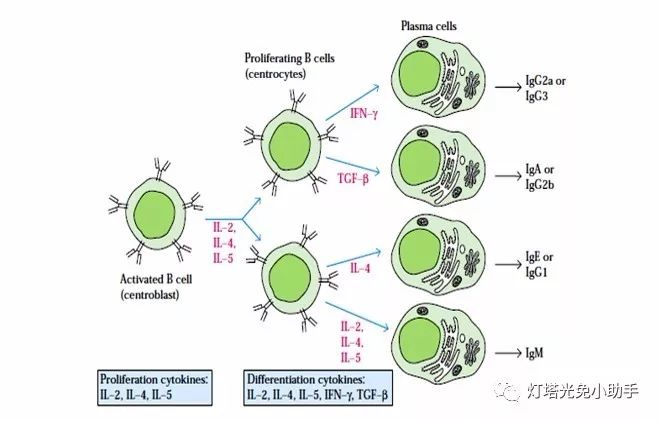抗体种类千千万,你知道原因吗?(二)
3.3类别转换
一个B淋巴细胞克隆在分化过程的初期,不成熟B细胞只表达mIgM和mIgD,这两种Ig具有相同的抗原结合区域。抗原激活B细胞后,膜上表达和分泌的Ig类别会从IgM转换成IgG、IgA、IgE等其他类别或亚类的Ig[12]。此时VH基因片段保持不变,而发生CH基因节段的重排,即结合抗原的特异性相同,但其重链类型(恒定区)发生改变。这样,同一B细胞的子代细胞就可以产生针对同一抗原的、特异性的、不同类别的抗体。局部微环境和细胞因子可影响和调节免疫球蛋白的类型转换[14]。
细胞因子调节B细胞Ig类别转换的机理可能是:(1)刺激某些细胞的克隆选择性的增殖,使分泌某特定类、亚类抗体的克隆细胞增加,如IL-5、IL-6促进IgA产生除通过同种型转换进行调节外,还可选择性促进IgA定向细胞分化增殖为IgA分泌细胞。(2)通过诱导特定位置上两个转换区的重组,诱导B细胞由分泌IgM向某一同种型Ig转换。
3.4体细胞高频突变和抗体的亲和力成熟
B细胞在完成重链基因、轻链基因的重排后,成熟的B细胞在外周淋巴器官生发中心接受抗原刺激后会发生高频度的突变,主要在重链区基因发生碱基点突变,称为体细胞高频突变(somatic hypermutation)[15]。体细胞的高频突变极大增加了免疫球蛋白基因的多样性,同时还可以使形成的抗体亲和力进一步成熟。
突变后产生的各种B细胞克隆的BCR亲和力各不相同,在其表面表达高亲和力抗体的B细胞会在与其他细胞的反应中获得强烈的存活信号,而表达低亲和力抗体的B细胞则逐渐凋亡[16]。其总体结果是,后代B细胞及其产生的抗体对抗原的平均亲和力得到了提升,称为抗体的亲和力成熟(affinity maturation),使所分泌的抗体可更有效地保护机体免受外来抗原的再次侵袭[17]。只有那些表达高亲和力抗原受体的B细胞,才能有效的结合抗原,并在抗原特异的Th细胞增殖,产生高亲和力抗体[17]。
在以上多样性抗体基因指导下,形成了多种多样的重链蛋白质分子和轻链蛋白质分子。此外,受体编辑、免疫球蛋白的类别转换等因素也可以大大增加免疫球蛋白结构的多样性[18]。可以说,自然界有多少种抗原物质,人体就能产生多少种免疫球蛋白分子,就能形成多少种抗体。
参考文献
1. Mann, Elizabeth R. "Intestinalantigen-presenting cells in mucosal immune homeostasis: Crosstalk betweendendritic cells, macrophages and B-cells". World Journal ofGastroenterology. 20 (29): 9653.
2. Kambayashi, Taku;Laufer, Terri M. "Atypical MHC class II-expressing antigen-presentingcells: can anything replace a dendritic cell?". Nature Reviews Immunology.14 (11): 719–730.
3. Den Haan, Joke M.M.;Arens, Ramon; Zelm, Menno C. van. (2014). "The activation of the adaptiveimmune system: Cross-talk between antigen-presenting cells, T cells and Bcells". Immunology Letters. 162 (2): 103–112.
4. Hivroz, Claire;Chemin, Karine; Tourret, Marie; Bohineust, Armelle. "Crosstalk between TLymphocytes and Dendritic Cells". Critical Reviews™ in Immunology. 32 (2): 139–155.
5. Dalod, M.; Chelbi, R.;Malissen, B.; Lawrence, T. (2014). "Dendritic cell maturation: functionalspecialization through signaling specificity and transcriptionalprogramming". The EMBO Journal. 33 (10): 1104–1116.
6. Sadegh-Nasseri,Scheherazade; Chou, Chih-Ling; Hartman, Isamu Z.; Kim, AeRyon; Narayan, Kedar(2012). "How HLA-DM works: recognition of MHC II conformationalheterogeneity". Frontiers in Bioscience. 4: 1325–1332.
7. Charles Janeway(2001). Immunobiology (5th ed.). Garland Publishing.
8. Al-Lazikani B, LeskAM, Chothia C (1997). "Standard conformations for the canonical structuresof immunoglobulins". J Mol Biol. 273 (4): 927–948.
9. Woof J, Burton D(2004). "Human antibody-Fc receptor interactions illuminated by crystalstructures". Nat Rev Immunol. 4 (2): 89–99.
10. Heyman B (1996)."Complement and Fc-receptors in regulation of the antibody response".Immunol Lett. 54 (2–3): 195–199.
11. Nemazee D (2006)."Receptor editing in lymphocyte development and central tolerance".Nat Rev Immunol. 6 (10): 728–740.
12. Market E, PapavasiliouFN (2003). "V(D)J recombination and the evolution of the adaptive immunesystem". PLoS Biol. 1 (1): E16.
13. Market, Eleonora;Papavasiliou, F. Nina (2003). "V(D)J Recombination and the Evolution ofthe Adaptive Immune System". PLoS Biology. 1 (1): E16.
14. Stavnezer J, AmemiyaCT (2004). "Evolution of isotype switching". Semin. Immunol. 16 (4):257–275.
15. Diaz M, Casali P(2002). "Somatic immunoglobulin hypermutation". Curr Opin Immunol. 14(2): 235–240.
16 Or-Guil M, WittenbrinkN, Weiser AA, Schuchhardt J (2007). "Recirculation of germinal center Bcells: a multilevel selection strategy for antibody maturation". Immunol.Rev. 216: 130–41.
17. Neuberger M,Ehrenstein M, Rada C, Sale J, Batista F, Williams G, Milstein C (2000)."Memory in the B-cell compartment: antibody affinity maturation".Philos Trans R Soc Lond B Biol Sci. 355 (1395): 357–360.
18. 曹雪涛,熊思东,姚智.医学免疫学.北京:人民医学出版社,2013:77.




















